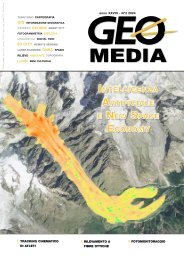GEOmedia_3_2016 special issue for INTERGEO
You also want an ePaper? Increase the reach of your titles
YUMPU automatically turns print PDFs into web optimized ePapers that Google loves.
<strong>INTERGEO</strong><br />
The first experience:<br />
the multi-scale survey<br />
of S. Pellegrino Terme<br />
This application regards the<br />
multi-scale survey with terrestrial<br />
laser scanning realized over<br />
the urban land of S. Pellegrino<br />
Terme, a small ancient town<br />
close to Bergamo (northern<br />
Italy).<br />
Advanced laser-scanning technologies<br />
were used, with a<br />
remarkable attention to the<br />
needed level of detail and with<br />
a careful look at buildings, their<br />
decorations and history. The<br />
reconstructed model was also<br />
utilized to create a virtual walkthrough<br />
<strong>for</strong> land investigation.<br />
The per<strong>for</strong>med survey has<br />
pointed out the original development<br />
of this settlement, designed<br />
<strong>for</strong> leisure and wellness,<br />
which was followed early by<br />
a gradual decadence that only<br />
new ideas and a renewed love<br />
<strong>for</strong> the site could overcome.<br />
The standards <strong>for</strong> urban model<br />
construction and management<br />
(city modelling) were proposed<br />
by the Open Geospatial<br />
Consortium (OGC) with the<br />
CityGML: these models are<br />
typically multi-scale 3D applications,<br />
ranging from landscape<br />
simulation to urban planning,<br />
from managing calamities to<br />
safety monitoring, etc.<br />
A modelling process requires<br />
the selection of geometric entities<br />
according to the chosen<br />
level of detail (LoD) and the<br />
attribution of textures <strong>for</strong> augmenting<br />
realism. This way,<br />
the survey approach <strong>for</strong> S.<br />
Pellegrino Terme documentation<br />
was established, together<br />
with the set of data to collect.<br />
It is known that laser scanning<br />
and imaging provide a dense<br />
object-point cloud, which can<br />
be geo-referenced in an assigned<br />
coordinate system. The geo-referencing<br />
is per<strong>for</strong>med either indirectly,<br />
through control points<br />
Fig. 6 - Orthographic elevations of the Spa-buildings, extracted from the point model.<br />
(pre-marked and measured on<br />
the object) and matching procedures<br />
based on natural features,<br />
or directly using satellite positioning<br />
and orientation devices.<br />
The localization quality is enhanced<br />
through differential<br />
positioning techniques via<br />
Internet corrections (code or<br />
phase), transmitted from a<br />
GNSS reference networks: a<br />
few centimetre accuracy (at<br />
95% likelihood) is guaranteed,<br />
either interactively via a RTK<br />
approach or in Post-Processing<br />
(PPK). In the described application,<br />
the GNSS reference<br />
network (NetGeo), by Topcon<br />
Positioning, was used.<br />
The direct geo-referencing,<br />
without control points and an<br />
alignment phase, is particularly<br />
convenient in applications<br />
regarding large areas (requiring<br />
several scans) when a level<br />
of detail equal or lower than<br />
LoD2-3 (likewise the scale<br />
1:200 or smaller) is required.<br />
Obviously, where the satellite<br />
signal is not guaranteed, due to<br />
urban obstructions, indirect or<br />
mixed geo-referencing have to<br />
be applied.<br />
Anyway, it is useful to select<br />
some check points (CP), among<br />
the control points (GCP), to<br />
assess the final accuracy of the<br />
process.<br />
Figure 2 shows the adopted<br />
scheme <strong>for</strong> capturing direct georeferenced<br />
object points: a laser<br />
scanner was used (Faro) and<br />
two satellite receivers (Topcon),<br />
fitted with a bracket respectively<br />
over the scanner and on an orientation<br />
point; both the receiv-<br />
18 Special Supplement to <strong>GEOmedia</strong> Journal Issue n. 3-<strong>2016</strong><br />
Fig. 7 - A view of the monastic complex in Albino


















